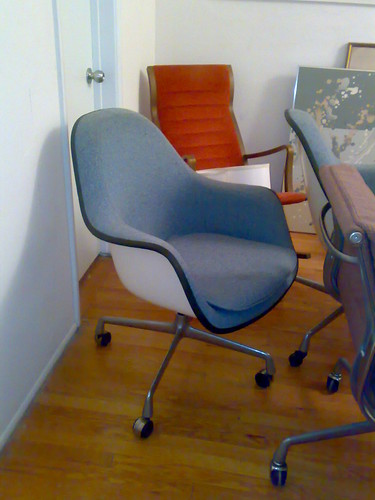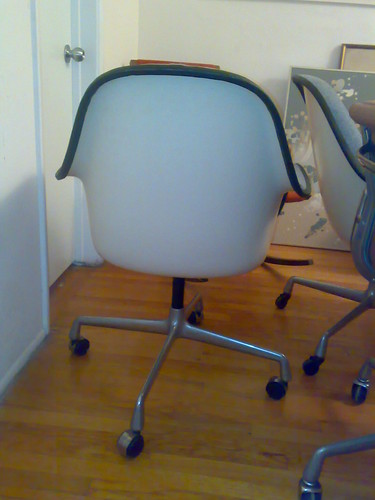In Blue fabric with original red hopsak underneath if you want to reclaim that style. The casters can be removed and plugged with glides from the following supplier for a sleeker look:
http://cgi.ebay.com/ALUMINUM-GROUP-HERMAN-MILLER-CHARLES-EAMES-GLIDES-/370458274112?pt=Antiques_Furniture&hash=item564108a940
The following history was provided by the Eames Office and photographs of this example can be viewed here: http://www.eamesoffice.com/vintage/worksheet_detail.php?id=76
I have several and they are in good condition. Additionally, the last photograph demonstrates another version of this chair that can be created by removing the upholstery.
Blessings



Naugahyde upholstery, fabric covered cushion, tilt-swivel base
Introduced in 1971, the Eames Office developed a new upholstery technique for this new sculptural shape. It has formed-in-place urethane foam filling. Quoting from EAMES DESIGN, by Ray Eames, Marilyn Neuhart and John Neuhart, "This unique process bonds together the chair's fabric or vinyl cover, foam core, and outer shell. The fabric is cut and sewn to size (except for the vinyl, which has no seams) and then vacuum-drawn into a mold. The matching mold is the already formed polyester seat shell. The molds with the sandwiched fabric are held together by a metal ring clamped to the shell's contour. Urethane foam is injected through a hole left in the seat mold, filling the space between the shell and the fabric and varying in thickness from 3/4 inch to 3 inches."
As with other innovations, this foam process, devised for this chair, was soon adapted to other chairs. From this point on, all the Eames shell chairs were upholstered in this manner.
In 1973, New York's Museum of Modern Art published a book, CHARLES EAMES FURNITURE FROM THE DESIGN COLLECTION - The Museum of Modern Art, New York, written by Arthur Drexler, Director of that museum's Department of Architecture and Design. Drexler was particularly enamored of this design, writing: "Although this chair might appear to be a padded version of the original 1950 plastic shell, its proportions differ from that design in two significant ways. The back support is 6" higher and makes up at least half the height of the entire shell; and the modelling of the inside back surface incorporates a reverse curve at its base, providing much firmer support. In addition, the chair's proportions are designed to include a lose seat cushion."
"Technically, this chair is among Eames' most sophisticated and carefully studied productions. Its plastic shell receives a formed-in-place urethane foam padding, covered, like the upholstered side chair, by a vinyl or fabric skin. Dents in this material slowly disappear, the urethane having a "memory" for its original contours.
A fabric or leather covering must be stitched; in vinyl the form is unbroken by this distracting detail, and every modulation of its curved surface is emphasized."
"Sleek, polished, impeccably detailed, the molded and padded shell of this chair suggests the world of aviation. It also manages to be at once precise and voluptuous, and seems to convey as much of the mood or image of its day as the plywood furniture did in the 'forties."
No comments:
Post a Comment